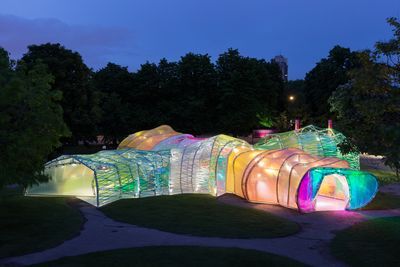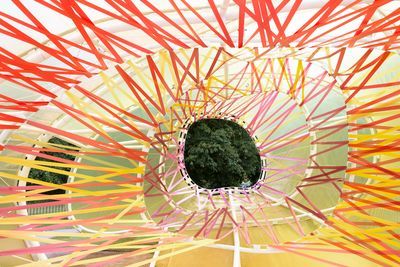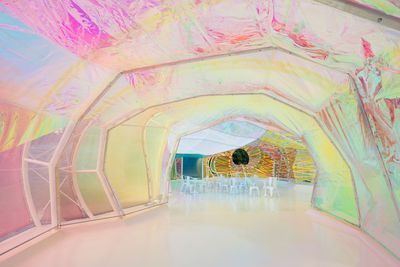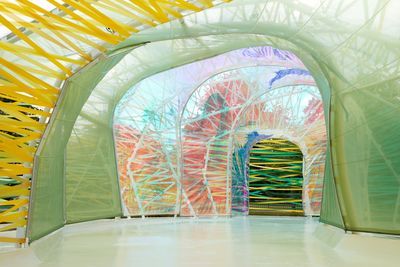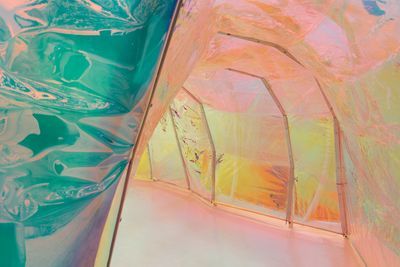The Serpentine's pi��ata pavilion
By MIKA ROSS-SOUTHALL
Temporary architecture was a rare and radical thing when the Serpentine Gallery started their summer pavilion project fifteen years ago. The prototype pavilion in 2000 was designed by Zaha Hadid, who, back then, was little more than a ���paper architect��� (barely any of her designs had been built); and many international heavyweights of the architectural (and occasionally art) world have been invited to create one every year since, including Daniel Libeskind, Oscar Niemeyer, ��lvaro Siza, Frank Gehry, Olafur Eliasson, Ai Weiwei and Herzog & de Meuron, as well as lesser-known names in the past couple of years.
Each pavilion takes six months from design to completion, and ���costs the same as it would to put up a tent on the park���s lawn���, Julia Peyton-Jones, the co-director of the Serpentine Gallery, reminded us yesterday at the opening of this year���s structure, designed by the Spanish architects SelgasCano (Jos�� Selgas and Luc��a Cano; they���re also responsible for a recent polytunnel-type pop-up caf�� just off Brick Lane). ���We commission the pavilion architects in the same way we commission artists in the gallery���, Peyton-Jones added. ���We push them with almost impossible requirements.���
Entering this pavilion is like stepping into a psychedelic greenhouse, or inside the abdomen of a supernatural insect. Woven strips of bold-coloured, translucent plastic (red, yellow, green, orange) and opalescent panels, stretched between white steel poles, are overlaid, angled and curved, creating patterned shadows and beautiful, shifting hues. A meandering path runs around some of the structure���s perimeter, with openings that either look outwards, framing sections of the park, or nudge you inwards, into different parts of the pavilion. If a little too tropical when the sun blasts through the layers of plastic, it���s nonetheless a happy, vibrant space ��� imagine a Spanish street fiesta.
Selgas described it yesterday as a ���pi��ata��� of small homages to the past pavilions in this anniversary year, while at the same time being experimental and new. You can feel the lightness and crosshatched shapes of, say, Sou Fujimoto���s (2013) and Gehry���s (2008), the handmade quality of Smiljan Radi�����s last year, and the angles of Toyo Ito���s (2002). What���s also been important to Selgas (coordinated with his own structure in bright orange trousers and a forest-green shirt) and Cano (all in white) is that it���s an urban project. They were inspired by the democratic space of London���s Underground, in particular, the way people navigate around each other in the tunnelled walkways.
How we relate to and use the structure is fundamental. So is sustainability: the pavilion needs to be easily dismantled and moved once it���s sold on, and the money made goes towards next year���s. After all, the pavilion is a public, not-for-profit space that aims to engage with, and inspire, contemporary architecture. And the Park Nights events held in the pavilion over the summer ��� one evening, ���Dying on Stage���, will feature a dance choreographed by the artist Christodoulos Panayiotou; another has the composer Christian Wolff ���play��� the pavilion ��� seem like just the stuff to achieve this; I���m particularly intrigued to see how the latter is pulled off.
���Architecture is not about the finished object���, Hans Ulrich Obrist, Peyton-Jones's fellow Serpentine director, told us: ���it���s not a relic, it���s an evolving process: what will happen to the pavilion in the next three months while it���s up, and how will people respond to it���. Isn���t this the best way to understand architecture, rather than through drawings, photographs or films? I think so; and, going by the number of passers-by waiting to see inside as we reluctantly trickled out, I���m not the only one.
Peter Stothard's Blog
- Peter Stothard's profile
- 30 followers


